Overview of Liposomes
Liposomes can be broadly defined as spherical vesicles with at least one lipid bilayer that encloses an aqueous core.
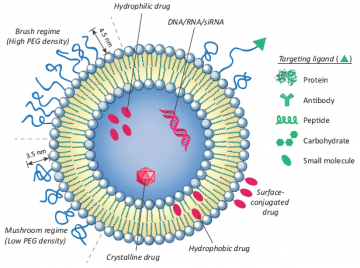 They can encapsulate both hydrophobic and hydrophilic drugs, and they serve as powerful vehicles for drug delivery.
They can encapsulate both hydrophobic and hydrophilic drugs, and they serve as powerful vehicles for drug delivery.
Liposomes can be manufactured with both top-down and bottom-up approaches, through methods such as thin-film hydration, reversed phase evaporation, solvent-injection or by using NanoAssemblr. Different manufacture techniques, lipid compositions and drug loading mechanisms result in liposomes with different characteristics and biodistribution, which allow liposomes to be synthesized for specific purposes. Because of their versatility and reduced side effects which improve patients’ quality of life, liposomes have various medical applications, such as tumor treatment, vaccine delivery and gene therapy.
Examples of Approved Liposomal Drugs
| Treatment | Active Drug | Liposomal Product | Liposomal Formulation |
| Cancer | Doxorubicin | Doxil/Caelyx | HSPC; Cholesterol;
DSPE-PEG |
| Myocet | EPC; cholesterol | ||
| Daunorubicin | Daunoxome | DSPC; cholesterol | |
| Fungal Infections | Amphotericin B | Abelcet | DMPC; DMPG |
| Ambisome | HSPC; cholesterol;
DSPG; vit. E |
||
| Cancers of White Blood Cell | Cytarabine | DepoCyt | cholesterol; triolein; DOPC; DPPG |
| Vincristine | Marqibo | Sphingomyelin;
cholesterol |
|
| Anaesthesia | Morphine | DepoDur | DOPC, DPPG, cholesterol and triolein |
Factors Affecting Biodistriobution of Liposomes
- Size
- >5nm to avoid renal filtration and <600nm to allow extravasation
- Liposomes <100nm display improved tissue penetration
- MLV: for local injections and sustained release
- SUV: better circulation for systemic injections
- Charge
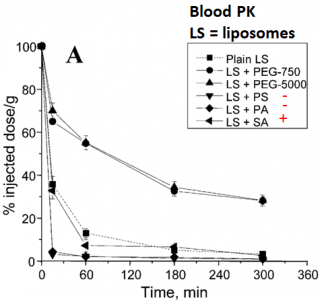
- Neutral liposomes: long circulation time and least RES interaction
- Anionic liposomes: more uptake in liver/ spleen due to RES interaction
- Cationic liposomes: exhibits aggregation with serum proteins; causes toxic effects
Figure 1. Levchenko et al. demonstrated in mice that in comparison to charged liposomes, neutral liposomes exhibit prolonged drug release.
- PEGylation
- Using PEGylated lipids to construct liposomes

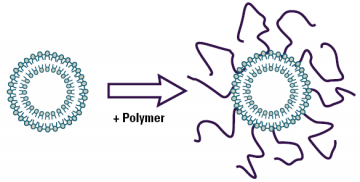
- Benefits
- Minimize serum protein binding and opsonisation through steric hindrance and charge shielding
- Prolong blood circulation and enhance antitumor efficacy by reducing RES interactions
- Possible Side-effects
- might induce immune response and hypersensitivity
- PEG mole ratio higher than optimal level can destabilize liposome
- Phase transition temperature (Tm)
- Temperature at which the lipid membrane transitions to fluid liquid
- Affected by chain length, degree of saturation, type of polar head group
- Presence of cholesterol stabilizes liposomes
- Controls drug release rate
- Drug loading mechanism
- Passive drug loading exhibits low efficiency and instability
- Active drug loading exhibits better encapsulation and stability
Factors Influencing Phases of Liposome Drug Delivery
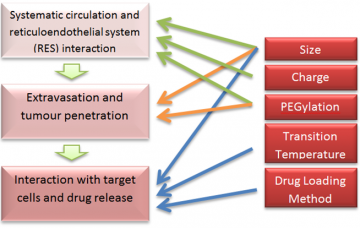
Medical Applications
- Sustained Release

- E.g. DepoFoam® Liposomal Technology
- using multivesicular liposomes with non-concentric aqueous chambers for sustained release
- Employed with Cytarabine, Morphine, Bupivacaine etc. to increase efficacy and improve patients’ quality of life
- Macrophage Targeting
- For systemic fungal infection
- Non-PEGylated and negatively charged liposomes target macrophages in liver and spleen
- E.g. Ambisomes deliver Amphotericin B with reduced nephrotoxicity and cardiotoxicity
- Tumor Treatment
- E.g. Caelyx®: PEGylated liposomal Doxorubicin
- Neutral liposomes, exhibit prolonged blood circulation
- Applied to breast cancer and ovarian cancer
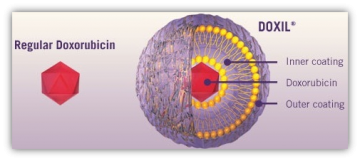
- Oral Absorption
- Applied to paediatric formulation to improve dosage flexibility and accommodate for different swallowing capabilities
- Vaccine Delivery
- Virosomes simulate viral membrane and exhibit better biocompatibility than conventional vaccines
- E.g. HAV vaccine Epaxal, influenza vaccine Inflexal V
- Higher seroprotection rate and fewer side effects
- Nucleic Acid Delivery
- E.g. siRNA delivery to silence PCSK9 and lower blood LDL level